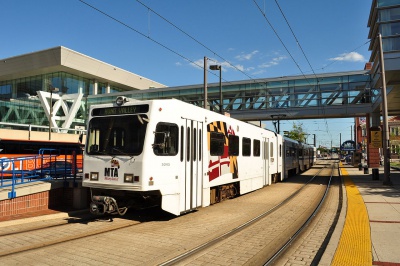Rail: Rail Station Planning
From MDOT Policy Manual
Contents
Primary Guidance
- Locations should be evaluated based on meeting specific criteria
- Are usually placed at major passenger generators and major transfer points.
- The minimum distance between existing and new systems will vary according to land use, population/employment generators, and the nature of the service.
- Underground stations are very expensive and should be reserved for high-density urban areas.
- Platform configuration should achieve a balance between passenger flow and system infrastructure and operations costs.
- Capacity should consider passenger LOS and passenger demand projected through a 20-year horizon.

Discussion
- Each Rail Station requires additional capital and operating costs and increased travel time for patrons. Planning should consider the factors below to determine if a station is warranted.
Rail Station Locations
- Location should be evaluated for the following criteria:
- Improves service quality and reliability;
- Strengthens intermodal connections;
- Aligns with existing or emerging employment, education and other community related services;
- Aligns with existing or emerging residential density; and
- Achieves ADA accessibility between the services point and the passenger destinations/generators.
Rail Station Spacing and Positioning
- Close spacing shortens walk distance for passengers, but increases transit trip time due to more stops and starts by the trains. Stations are usually placed at major passenger generators and major transfer points. Closer spacing (1/2 mile or less) is appropriate where adjacent land uses and population/employment densities warrant.
Spacing also depends on the nature of the service. Long distance commuter service generally has stations that are further apart, while short-hop local service has stations that are closer together.
Rail Station Type and Configuration
- A transit system’s alignment, in part, determines whether the stations are at-grade, aerial or underground.
- At-grade stations are cost effective and provide more flexibility for access than aerial stations.
- Underground stations are very expensive with limited opportunities for access. They are usually reserved for dense urban settings with a higher ridership demand or locations with restrictive surface requirements.
- Aerial stations are less expensive than underground stations, but more expensive than at-grade stations. Aerial stations achieve the operational benefits of underground stations, but can sometimes affect the surrounding aesthetics. For instance, vertical circulation elements (VCEs) such as stairs and elevators, and mezzanines are usually required to access aerial stations. These can be large prominent structures that need to be integrated with sidewalks, plazas, buildings, utilities and other urban elements.
- Stations can be configured with either side or center platforms to achieve a balance between passenger flow and system infrastructure and operations costs. Elevators, escalators and ventilation systems should be considered when choosing station type.
Rail Station Capacity
- Stations should be planned to accommodate capacity based on projected demand 20 years beyond the day of opening. The primary areas used for passenger waiting and circulation should be sufficiently sized to accommodate peak passenger demand without compromising safety or convenience.
- LOS for rail stations is defined by the Transit Capacity and Quality of Service Manual (TCRP Report 165), which describes the different LOS criteria for each design element such as a walkway, platform, and stairs.
- In cases where an acceptable LOS for the forecasted patronage cannot be achieved with an acceptable station size and cost, other system characteristics such as more frequent trains (reduced headways) may be considered. However, reduced headways will require purchasing more trains, more operators, increased traction power requirements, and possibly a larger storage yard.
Rail Station Security
- Stations should be planned to include systems elements for communications, control and monitoring, and safety and security. These systems ensure safe operations, and provide secure facilities for customers. Systems elements include cameras (CCTV), public address (PA) system, variable messaging sign system, emergency trip stations and blue light stations, fire protection and smoke management systems. Most of these systems are tied to an Operations Control Center, usually located separate from the station facility.